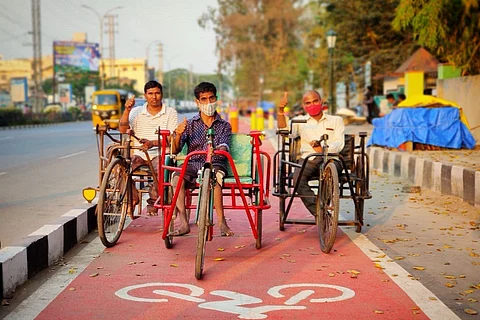

When the Union government announced ‘India’s top 11 cycling pioneers’ as part of the Cycles for Change challenge, Warangal was the only city from Telangana to find a mention. Warangal and 10 other cities, which topped among 107 cities that participated, will receive Rs 1 crore each to scale up their cycling initiatives. At present, Warangal has four km of pop-up cycle lanes coloured red, with permanent segregation from motorised traffic. Officials say that the plan is to scale up the initiative to over 50 km.
So how did Warangal manage to grab one of the top spots? Cycling has always been a part of any growing city’s culture, but with the advent of technology, there has been a shift to other modes of transport. However, in Warangal, with the presence of broad roads, National Highways, and students from institutes like the National Institute of Technology (NIT) and others, the culture of cycling never died down, Warangal municipal officials say.
“As Warangal was planning smart city roads, having pop-up cycle lanes was always a part of the plan. However, we went an extra mile when we decided to participate in the Cycles for Change Challenge,” says Anand Voleti, team leader of the Warangal Smart City project. Anand explains that it all started with a ‘handlebar’ survey in the city of cyclists, through which the municipality learnt about the challenges that they were facing.
The cities that were participating in the challenges were required to continuously test, learn and scale up their cycling initiatives at each stage. However, what Warangal did was unique, says Anand. “For cyclists, there is always a risk with motorised traffic who are using the road along with them. In case of any untoward incident, motorised traffic may hit cyclists. In order to avoid this, we have come up with a permanent segregation. Warangal is the only city to have permanent segregation for a non-motorised traffic lane. Most other cities have only flexible plastic bollards, which might not be efficient in protecting the cyclists from being hit by a motorist,” says Anand.
The transformation was not without challenges. The pop-up lane which was created for cyclists soon turned into a parking lane for many street vendors and commercial complexes on the road. The municipality also set up bollards that prevented other vehicles from entering the lane. “Bringing behavioral change among the citizens about parking on cycle lanes was one of the main challenges. But countries like London also have come up with similar solutions. Bollards were placed, restrictions were made, and we took the help of police and increased surveillance, imposed fines, and made the vehicles park in their own commercial complexes,” Anand says.
While on one hand, infrastructure was being scaled up, the city also came up with awareness campaigns for various age groups, trying to encourage them into the habit of cycling. Competitions including cycling events were held, and the city also distributed cycles to underprivileged people in need.
The Greater Warangal Municipal Corporation (GWMC) says that at present, on some days, the cycle lane from Fathima junction to the Subhedari road sees hundreds of cyclists during peak hours. For now, the city is planning to extend the cycle lane to another 50 km, which is estimated to cost upto Rs 40 crore to Rs 50 crore. Apart from the students and other citizens, there are also a couple of active cycling clubs present in Warangal, which promote cycling as a healthy habit. The cyclists feel that the cycling track can be made even better.
Anudeep Ceremilla, from Kakatiya Cycling club, says that there are still some pitfalls in the cycling paths, which need to be improved further. “Cycling has picked up in the city, especially during the pandemic. But the cycling track that is set up here needs to be more cycling friendly. The stretch near the NIT Warangal campus is alright but at some other locations, the stretch is uneven and is at different heights.”